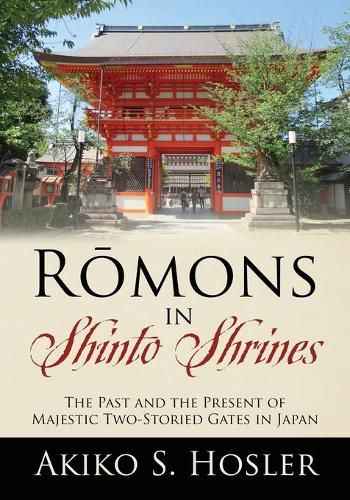Readings Newsletter
Become a Readings Member to make your shopping experience even easier.
Sign in or sign up for free!
You’re not far away from qualifying for FREE standard shipping within Australia
You’ve qualified for FREE standard shipping within Australia
The cart is loading…






This title is printed to order. This book may have been self-published. If so, we cannot guarantee the quality of the content. In the main most books will have gone through the editing process however some may not. We therefore suggest that you be aware of this before ordering this book. If in doubt check either the author or publisher’s details as we are unable to accept any returns unless they are faulty. Please contact us if you have any questions.
Romon is a traditional two-storied gate found in a place of worship in Japan. Ro means multi-storied , and mon means gate in Japanese. A typical romon in Japan is constructed with wood; massive and decorative; and has a large hip-and-gable roof and a wraparound small balcony with railings. Romons that are noted for their artistic beauty and historical significance tend to belong to Shinto shrines. Yet no one can answer such simple question as how many romons exist in Shinto shrines in Japan. This very first book about Shinto romons has two parts. Part 1 is about reporting results of my search for existing Shinto romons across Japan. First, I explain the unique and systematic techniques I used to search for existing romons. Then I report findings from my search. Results are organized by various topics, such as time of construction, geographic location, relative spatial position, notable exterior characteristics, zuijin statues, and preservation of romons. Findings are primarily aggregated at the group level, but notable examples of individual cases (specific romons) are also provided. In short, Part 1 is designed to answer such basic questions as What is romon?
What do they look like? and Where are they located? Part 2 is about lost Shinto romons. The existing romons are only a small part of the romons that have ever been built, and on average in every several years a romon is lost due to fire, earthquake, old age, among other reasons. Part 2 consists of a collection of fascinating stories and trivia of lost Shinto romons. These stories and trivia relate to specific shrines, famous persons, or historic events, and are organized chronologically. Examples of topics include Iwashimizu Hachimangu - Eight Generations of Romons , Kashiwahgi Jinja - Musical Chairs of Romons , The Toyotomi Clan vs. the Tokugawa Clan - Who is the Romon Shogun? , End of the Syncretism - Did Shinto Shrines Lose Romons? and A Forgotten Lost Shinto Romon Overseas. This book also contains 12 tables, 8 figures, a glossary of Shinto gates, and bibliography. Finally, the appendix lists all 225 existing romons, their locations, structural designs, and historic preservation designations.
$9.00 standard shipping within Australia
FREE standard shipping within Australia for orders over $100.00
Express & International shipping calculated at checkout
This title is printed to order. This book may have been self-published. If so, we cannot guarantee the quality of the content. In the main most books will have gone through the editing process however some may not. We therefore suggest that you be aware of this before ordering this book. If in doubt check either the author or publisher’s details as we are unable to accept any returns unless they are faulty. Please contact us if you have any questions.
Romon is a traditional two-storied gate found in a place of worship in Japan. Ro means multi-storied , and mon means gate in Japanese. A typical romon in Japan is constructed with wood; massive and decorative; and has a large hip-and-gable roof and a wraparound small balcony with railings. Romons that are noted for their artistic beauty and historical significance tend to belong to Shinto shrines. Yet no one can answer such simple question as how many romons exist in Shinto shrines in Japan. This very first book about Shinto romons has two parts. Part 1 is about reporting results of my search for existing Shinto romons across Japan. First, I explain the unique and systematic techniques I used to search for existing romons. Then I report findings from my search. Results are organized by various topics, such as time of construction, geographic location, relative spatial position, notable exterior characteristics, zuijin statues, and preservation of romons. Findings are primarily aggregated at the group level, but notable examples of individual cases (specific romons) are also provided. In short, Part 1 is designed to answer such basic questions as What is romon?
What do they look like? and Where are they located? Part 2 is about lost Shinto romons. The existing romons are only a small part of the romons that have ever been built, and on average in every several years a romon is lost due to fire, earthquake, old age, among other reasons. Part 2 consists of a collection of fascinating stories and trivia of lost Shinto romons. These stories and trivia relate to specific shrines, famous persons, or historic events, and are organized chronologically. Examples of topics include Iwashimizu Hachimangu - Eight Generations of Romons , Kashiwahgi Jinja - Musical Chairs of Romons , The Toyotomi Clan vs. the Tokugawa Clan - Who is the Romon Shogun? , End of the Syncretism - Did Shinto Shrines Lose Romons? and A Forgotten Lost Shinto Romon Overseas. This book also contains 12 tables, 8 figures, a glossary of Shinto gates, and bibliography. Finally, the appendix lists all 225 existing romons, their locations, structural designs, and historic preservation designations.